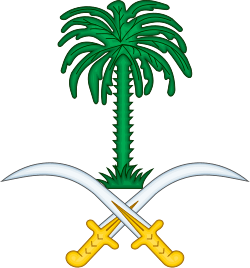Saudi Arabian art
Saudi Arabian art should be understood in the light of the country being the birthplace of Islam and to include both the arts of Bedouin nomads and those of the sedentary peoples of regions such as the Hejaz, Tihamah, Asir and the Najd.
Architecture
The first mosque of Islam was the house of the Islamic prophet Mohammed in Medina. It is the prototype of all later sacred architecture of Islam. In it are most important the floor and carpet that are touched in prayer with the head.[1] There are different regional styles of architecture in Saudi Arabia, and they are divided into different styles. In the Najd region, most buildings are made of mud-brick covered by mud-plaster. In the Hijaz region, most buildings are made of coral rag and wood, with roofs made of palm thatch and wooden beams. There are many Ottoman influences on the architecture in this region.[2]
In the Al-Hufud regions, the houses are usually two or three stories and they surround a central courtyard.[2]
In the Asir region, many houses are made of rough-cut stone, and other houses are made of a stone and mud combination.[2]
Visual arts
Tribal symbols referred to as "wusum" were carved by Bedouins during prehistoric times and are found as rock art in the hills and deserts of Arabia. During the years 1985-1990l there was a rock art and epigraphic survey of Saudi Arabia. During this time, over 1000 rock art sites were recorded. In the earlier stages of rock art, there were large human and animal faces, and in the later stages the human and animals faces were smaller.[3]
Art Movement
The Art Movement in Saudi Arabia started in the mid 60's by a group of School Art Teachers and lasted till mid 80's.
In 1972 Mohammed Said Farsi became the mayor of the coastal city of Jeddah, making the city one of the largest open-air art galleries in the world.
Portable art forms
There are many portable art forms in Saudi Arabia. For example, there is metalware, jewelry, pottery and leatherwork. Even today, many Bedouin women weave, and they make brightly colored striped rugs, camel trapping and tents. The tents are black and are made of goat-hair, mixed with sheep’s wool and camel-hair.[2]
See also
Bibliography
- Majeed Khan: Wusum, the tribal symbols of Saudi Arabia, Kingdom of Saudi Arabia, Ministry of Education, 2000.
- Anthony Ham a.o.: Saudi Arabia, Lonely Planet, 2004.
- Dr. Muhammed Kamal Ismail a.o.: The archiceture of the Holy Mosque, Makkah, London, 1998.
- Robert Hillenbrand: Islamic Art and Architecture, Thames & Hudson, London, 2004 (1999).
- Marcel Kurpershoek: De laatste bedoeïen, Amsterdam, 1995.
References
